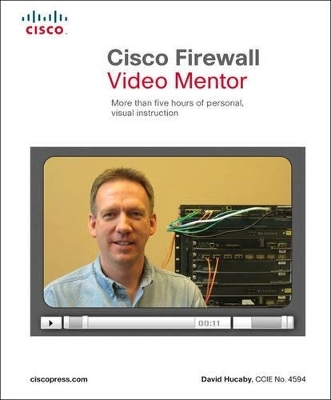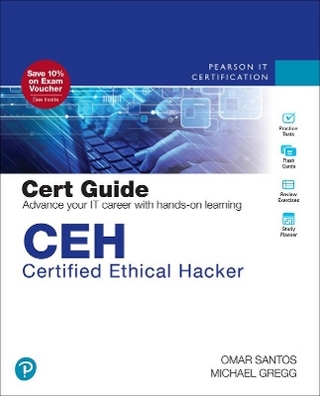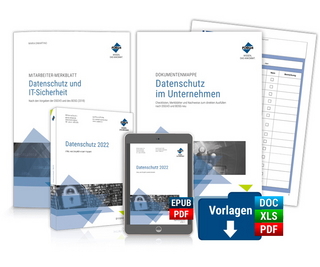
Cisco Firewall Video Mentor (Video Learning)
Cisco Press
978-1-58720-198-1 (ISBN)
- Titel ist leider vergriffen;
keine Neuauflage - Artikel merken
—Mark Macumber, Systems Engineer, Cisco
Cisco Firewall Video Mentor is a unique video product that provides you with more than five hours of personal visual instruction from best-selling author and lead network engineer David Hucaby. In the 16 videos presented on the DVD, David walks you through common Cisco® firewall configuration and troubleshooting tasks. Designed to develop and enhance hands-on skills, each 10–30 minute video guides you through essential configuration tasks on the Cisco ASA and FWSM platforms and shows you how to verify that firewalls are working correctly.
Lab Layout:
Each video lab presents objectives, dynamic lab topology diagrams, command syntax overviews, and video captures of command-line input and GUI configuration. All of this is coupled with thorough audio instruction by an industry expert making learning easy and engaging.
Network Animation:
Animated network diagrams show you lab setup, device addressing, and how traffic flows through the network.
Command-Line Interface (CLI) Video:
Video screencasts of ASA and FWSM CLI and the ASDM GUI demonstrate command entry, configuration techniques, and device response.
This video product is part of the Cisco Press® Video Mentor Series. The video products in this series present expert training from industry-leading instructors and technologists. This dynamic learning environment combines animations, screencasts, and audio instruction to help users bridge the gap between conceptual knowledge and hands on application.
System Requirements:
Microsoft Windows XP, 2000, or Vista
Apple OS 9 or later
Linux operating systems that have a web browser with Flash 7 or later plug-in
Speakers or headphones
Color display with a minimum 1024x768 resolution
1 GHz or faster CPU recommended
DVD drive
David Hucaby, CCIE® No. 4594, is a lead network engineer for the University of Kentucky, where he works with healthcare networks based on the Cisco® Catalyst®, ASA/PIX®/FWSM security, and VPN product lines. David was one of the beta reviewers of the ASA/PIX 7.0 and 8.0 operating system software. David has a B.S. and M.S. in electrical engineering from the University of Kentucky and has worked in the IT field for 19 years. He lives in Kentucky with his wife Marci and two daughters.
Lab 1 Initial Configuration 1
Scenario 1
Initial Configurations 1
Video Presentation Reference 1
Step 1: Connect to the Firewall Console 2
Step 2: Explore the CLI Modes 2
Step 3: Search the CLI Output 3
Step 4: Set the Firewall Hostname and Domain Name 4
Lab 2 Configuring Interfaces 5
Scenario 5
Initial Configurations 5
Video Presentation Reference 5
Step 1: Set the Firewall Mode 6
Step 2: Configure Interface Parameters 6
Step 3: Configure a Physical Interface 6
Step 4: Configure a Redundant Interface 7
Step 5: Configure a Logical VLAN Interface 8
Lab 3 Setting Up Routing 11
Scenario 11
Initial Configurations 11
Video Presentation Reference 12
Step 1: Configure Static Routes 12
Step 2: Configure a Default Route 12
Step 3: Configure the Standby ISP 13
Step 4: Use a Dynamic Routing Protocol 14
Lab 4 Firewall Administration over the Network 15
Scenario 15
Initial Configurations 15
Video Presentation Reference 16
Step 1: Set Up Telnet Access 16
Step 2: Set Up SSH Access 17
Step 3: Set Up ASDM Access 17
Step 4: View ASDM Session Demonstration 18
Lab 5 Using Multiple Security Contexts 19
Scenario 19
Initial Configurations 19
Video Presentation Reference 19
Step 1: Enable Multiple Context Mode 19
Step 2: Create New Security Contexts 20
Step 3: Administer Contexts Through the CLI 22
Step 4: Configure Security Contexts and Their Interfaces 22
Step 5: Learn Context Arrangement 23
Lab 6 Using Failover for High Availability 25
Scenario 25
Initial Configurations 25
Video Presentation Reference 29
Step 1: Identify the Failover Role 29
Step 2: Set Up LAN-Based Failover 29
Step 3: Set Up Stateful Failover 31
Step 4: Tune the Unit Failover Threshold 31
Step 5: Set Up the Active-Active Failover Groups 32
Step 6: Define Context Interface Addresses 32
Step 7: Assign Contexts to the Two Failover Groups 34
Step 8: Bootstrap the Secondary Firewall Unit 35
Monitoring Failover Operation 35
Lab 7 Failover in Action 37
Scenario 37
Initial Configurations 38
Video Presentation Reference 38
Scenario 1: Physical Interface Failure 38
Scenario 2: Logical Interface Failure 38
Scenario 3: Failover Unit Failure 39
Scenario 4: Hitless Code Upgrade 39
Lab 8 Setting Up Address Translation and Connection Limits 45
Scenario 45
Initial Configurations 45
Video Presentation Reference 46
Step 1: Configure Static NAT 46
Step 2: Configure Policy NAT 47
Step 3: Configure Identity NAT 48
Step 4: Configure NAT Exemption 48
Step 5: Configure Dynamic NAT and PAT 49
Step 6: Set UDP and TCP Connection Limits 50
Lab 9 Setting Up Firewall Rules 51
Scenario 51
Initial Configurations 51
Video Presentation Reference 52
Step 1: Configure an Access List for the Inside Interface 52
Step 2: Configure an Access List for the Outside Interface 52
Step 3: Configure a Network Object Group 53
Step 4: Configure an Enhanced Service Object Group 54
Step 5: Configure an Access List to Use the Object Groups 55
Lab 10 Setting Up a DMZ 57
Scenario 57
Initial Configurations 57
Video Presentation Reference 58
Step 1: Consider Connections from the Inside Toward the DMZ 59
Step 2: Consider Connections from the DMZ Toward the Outside 59
Step 3: Consider Connections from the Outside Toward the DMZ 59
Step 4: Consider Connections from the DMZ Toward the Inside 60
Step 5: Review the DMZ Access List for Conflicting Entries 60
Lab 11 Setting Up Logging 63
Scenario 63
Initial Configurations 63
Video Presentation Reference 64
Step 1: Send Logging Messages to the Internal Buffer 65
Step 2: Send Logging Messages to an ASDM Session 65
Step 3: Send Logging Messages to a Syslog Server 66
Lab 12 Using MPF to Control Layer 3/4 Connections 67
Scenario 67
Initial Configurations 67
Video Presentation Reference 68
Step 1: Classify Interesting Traffic with a Class Map 69
Step 2: Define a Policy with a Policy Map 69
Step 3: Apply the Policy 70
Step 4: Monitor the Policy 70
Lab 13 Using MPF to Perform QoS Queuing and Policing 71
Scenario 71
Initial Configurations 71
Video Presentation Reference 72
Step 1: Send Traffic to the Priority Queue 72
Step 2: Use a Policer to Limit Bandwidth 73
Lab 14 Using MPF to Tune Application Inspection Engines 75
Scenario 75
Initial Configurations 75
Video Presentation Reference 76
Step 1: Enable an Inspection Engine 76
Step 2: Change the Inspection Engine Listening Port 77
Step 3: Use an Inspection Policy Map 77
Step 4: Use an Inspection Regex Match 78
Lab 15 Testing Security Policies with Packet Tracer 79
Scenario 79
Initial Configurations 79
Video Presentation Reference 83
Step 1: Send an Outbound ICMP Packet Through a Static Address Translation 83
Step 2: Send an Outbound ICMP Packet Through a Dynamic Address Translation 83
Step 3: Send an Inbound ICMP Packet 84
Step 4: Send an Outbound TCP Packet Through an Application Inspection Engine 84
Lab 16 Capturing Traffic 85
Scenario 85
Initial Configurations 85
Video Presentation Reference 89
Step 1: Configure a Raw Data Capture Through the CLI 89
Step 2: Configure an ASP Drop Capture Through the CLI 89
Step 3: Copy the Capture Buffer to an External Host 90
Step 4: Configure a Capture Session with ASDM 90
| Erscheint lt. Verlag | 22.5.2008 |
|---|---|
| Verlagsort | Indianapolis |
| Sprache | englisch |
| Maße | 233 x 194 mm |
| Gewicht | 372 g |
| Themenwelt | Informatik ► Netzwerke ► Sicherheit / Firewall |
| ISBN-10 | 1-58720-198-4 / 1587201984 |
| ISBN-13 | 978-1-58720-198-1 / 9781587201981 |
| Zustand | Neuware |
| Haben Sie eine Frage zum Produkt? |
aus dem Bereich


